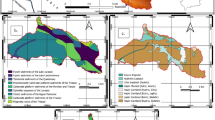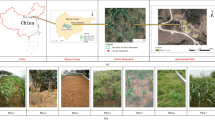Abstract
Rainfall and run-off prediction capabilities for flash flood need improvement in the high porn regions of mountain hazard, those caused massive distraction. At some point, these events result in a massive loss of life and property. This research demonstrates the application of soil conservation service (SCS), a hydrological model used to simulate the relationship between rainfall and run-off. The data cover a 62-year observation period of torrential rains and debris flows, which number up to thirty flow events, all occurring in the mountainous regions close to the Tieli watershed area. Rainfall hydrographs were generated for each of the said torrential rain cases and can be used as markers for flood warnings for critical rainfalls lasting from 1 to 24 h. The results show that the SCS model can successfully define the rainfall–run-off-water level relationship of small-medium-size catchments wherein the calculated run-off values show good agreement with measured discharges. Moreover, from the relationship of the water level and SCS calculated run-off is similar to the relationship obtained using measured run-offs. From this relationship, critical water levels that would correspond to the occurrence of a possibly devastating flood can be determined to provide for an early warning measure for the nearby regions.










Similar content being viewed by others
References
Ajmal M et al (2015) Investigation of SCS–CN and its inspired modified models for runoff estimation in South Korean watersheds. J Hydro-environ Res 9(4):592–603
Anon (2008) Hydrological information forecasting specification (GB/T 22482–2008). China Standard Press, Beijing
Anon (2017) Proceedings of the 18th international conference on distributed computing and networking. ed., Hyderabad, India, p 367.
Bardossy A, Das T (2008) Influence of rainfall observation network on model calibration and application. Hydrol Earth Syst Sci 12(1):77–89
Bazai NA, Cui P, Carling PA, Wang H, Hassan J, Liu D, Zhang G, Jin W (2021) Increasing glacial lake outburst flood hazard in response to surge glaciers in the Karakoram. Earth Sci Rev 212:103432
Bosznay MS (1989) Generalization of SCS Curve Number Method. J Irrig Drain Eng 115(115):139–144
Bouyoucos GJ (1962) Hydrometer method improved for making particle size analysis of soils. Agron J 54:464–465
Chandrmohan T, Durbude D (2001) Estimation of runoff using small watershed models. Hydrol J 24:45–53
Chen N et al (2010) The critical rainfall characteristics for torrents and debris flows in the Wenchuan earthquake stricken area. J Mount Sci 6:362
Chen Z, Liu X, Zhu B (2014) Runoff estimation in hillslope cropland of purple soil based on SCS–CN model. Trans Chin Soc Agric Eng 30(7):72–81
Cui P, Jia Y (2015) Mountain hazards in the Tibetan Plateau: research status and prospects. Nat Sci Rev 2(4):397–399
Dahal RK, Hasegawa S (2008) Representative rainfall thresholds for landslides in the Nepal Himalaya. Geomorphology 100(3):429–443
Elhakeem M, Papanicolaou AN (2009) Estimation of the runoff curve number via direct rainfall simulator measurements in the State of Iowa, USA. Water Resour Manag 23(12):2455–2473
Giannecchini R, Galanti Y, Avanzi GD (2012) Critical rainfall thresholds for triggering shallow landslides in the Serchio River Valley (Tuscany, Italy). Nat Hazard Earth Syst Sci 12(3):829–842
Greene RG, Cruise JF (1995) Urban watershed modeling using geographic information system. J Water Resour Plan Manag 121(4):318–325
Hadley RF, Schumm SA (1961) Sediment Sources and Drainage Basin Characteristics in Upper Cheyenne River Basin 1531:137–196
Hawkins RH (1993) Asymptotic determination of runoff curve numbers from data. J Irrig Drain Eng 119(2):334–345
Hawkins RH (1996) Discussion: SCS runoff equation revisited for variable-source runoff areas. J Irrig Drain Eng 122(5):319–320
Hosseini SM, Mahjouri N (2018) Sensitivity and fuzzy uncertainty analyses in the determination of SCS–CN parameters from rainfall–runoff data. Hydrol Sci J/journal Des Sciences Hydrologiques 63:457–473
Hosseini SM, Mahjouri N, Riahi S (2017) Closure to “Development of a Direct Geomorphologic IUH Model for Daily Runoff Estimation in Ungauged Watersheds” by Seiyed Mossa Hosseini, Najmeh Mahjouri, and Samaneh Riahi. J Hydrol Eng 22(6):07017002
Huang M et al (2010) Use of soil moisture data and curve number method for estimating runoff in the Loess Plateau of China. Hydrol Processes 21(11):1471–1481
Ipcc et al (2013) The physical science basis. Contribution of Working Group I to the Fifth Assessment Report of the Intergovernmental Panel on Climate Change.
Jiao P et al (2015) Conceptualizing antecedent runoff condition using recurrence relation to modify SCS model. Trans Chin Soc Agric Eng 31(12):132–137
King KW, Balogh JC (2008) Curve numbers for golf course watersheds. Trans ASABE 51(3):987–996
Li CJ, Ma TH (2011) Reflections on the catastrophic debris flow event in Zhouqu County: how to minimize casualties? Geol Rev 57(5):687–698
Li LI et al (2012) Distributed application of SCS model to flood simulation in middle reaches of Yellow River. J Hohai Univ 40(1):104–108
Li M, Yuan S, Xiaojun G (2011) Heilongjiang province mountain torrent disaster survey and prevention measures. Heilongjiang Sci Technol Water Conserv 5:149–150
Ma T et al (2014) An effective antecedent precipitation model derived from the power-law relationship between landslide occurrence and rainfall level. Geomorphology 216:187–192
McIntyre, D. S. and Loveday, J. 1974. Bulk density. In Loveday J (ed) Metode of analysis for irrigated soil, vol 54. Common Wealth Agricultural Bureau of Technical Communication, Farnham Royal
Melesse AM, Shih SF (2002) Spatially distributed storm runoff depth estimation using Landsat images and GIS. Comput Electron Agric 37(1):173–183
Mishra SK et al (2005a) Field applicability of the SCS–CN-based Mishra-Singh general model and its variants. Water Resour Manag 19(1):37–62
Mishra SK et al (2005b) Catchment area-based evaluation of the AMC-dependent SCS-CN-based rainfall–runoff models. Hydrol Process 19(14):2701–2718
Mishra SK, Singh VP (2003) Soil conservation service curve number (SCS–CN) methodology. Springer, Berlin
Mishra SK, Singh VP (2010) Validity and extension of the SCS–CN method for computing infiltration and rainfall-excess rates. Hydrol Processes 18(17):3323–3345
Mishra SK et al (2006) SCS–CN-based modeling of sediment yield. J Hydrol 324(1):301–322
Ponce VM, Hawkins RH (1996) Runoff curve number: has it reached maturity? J Hydrol Eng 1(1):11–19
Qu M, Ming J (2014) Mountain torrent disaster survey evaluation in Heilongjiang province in near future. Heilongjiang Sci Technol Water Conserv 9:30–32
Romero P et al (2007) Curve Number Values for Olive Orchards under Different Soil Management. Soil Sci Soc Am J 71(6):1758–1769
Rozalis S et al (2010) Flash flood prediction using an uncalibrated hydrological model and radar rainfall data in a Mediterranean watershed under changing hydrological conditions. J Hydrol 394(1–2):245–255
SCS (1972a) (Soil Conservation Service), National engineering handbook, part 630 hydrology. Natural Resources Conservation Service, US Department of Agriculture, Washington, DC
SCS (1972b) Soil conservation service, national engineering handbook. USDA, Washington, D.C
Sharma D, Kumar V (2002) Application of SCS model with GIS database for estimation of runoff in an arid watershed. J Soil Water Conserv 30(2):141–145
Sharma T et al (2001) Hydrologic response of a watershed to land use changes: A remote sensing and GIS approach. Int J Remote Sens 22(11):2095–2108
Shi ZH et al (2009) Research on the SCS–CN initial abstraction ratio using rainfall-runoff event analysis in the Three Gorges Area, China. CATENA 77(1):1–7
Singer MJ, Tate KW (2000) Applicability of SCS curve number method for a California Oak woodlands watershed. J Soil Water Conserv 55(2):226–230
Steenhuis TS et al (1995) SCS Runoff Equation Revisited for Variable-Source Runoff Areas. J Irrig Drain Eng 121(3):234–238
Sun L, Song C, Zhang X (2012) Development potential and basic analysis of modern agriculture in Heilongjiang Province. Heilongjiang Sci Technol Water Conserv 1:256–257
Tan WP, Han QY (1992) Study on regional critical rainfall indices of debris flow in Sichuan Province. J Catastrophol
Tsihrintzis VA, Hamid R (2010) Urban stormwater quantity/quality modeling using the SCS method and empirical equations. J Am Water Resour Assoc 33(1):163–176
Veihmeyer FJ, Hendrickson AH (1949) Methods of measuring field capacity and permanent wilting percentage of soils. Soil Sci 68(1):75–94
Viji R, Prasanna PR, Ilangovan R (2015) Modified SCS–CN and Green–Ampt methods in surface runoff modelling for the Kundahpallam Watershed, Nilgiris, Western Ghats, India. Aquat Procedia 4:677–684
Wen G (2017) Application of modified SCS model in runoff simulation for medium- and small-sized basins in Heilongjiang Province. Hohai University, Master
Wilcox BP et al (1990) Predicting runoff from rangeland catchments: a comparison of two models. Water Resour Res 26(10):2401–2410
Yang YCE et al (2015) Estimation of flood damage functions for river basin planning: a case study in Bangladesh. Nat Hazards 75(3):2773–2791
Yanyu LU, Tian H, Centre AC (2015) Mechanism-oriented approach for estimating critical rainfall of flood disaster: a case study based on HBV model. Meteorol Month 41:755–760
Zhang G, Cui P, Yin Y, Liu D, Jin W, Wang H, Yan Y, Ahmed BN, Wang J (2019) Real-time monitoring and estimation of the discharge of flash floods in a steep mountain catchment. Hydrol Process 33(25):3195–3212
Zhou C, Ren S, Yan M (2008) Application of SCS model to simulate rainfall-runoff relationship in Wenyu river basin in Beijing. Trans Chin Soc Agric Eng 3(6):e2359
Acknowledgements
This study was supported by National Natural Science Foundation of China (Grant No. 41941017) as well by Major International (Regional) Joint Research Project (Grant No. 41520104002) and Second Tibet Plateau Scientific Expedition and Research Program (STEP) (Grant No. 2019QZKK0906). The research was sponsored by the CAS-TWAS President's Fellowship for international Ph.D. students.
Author information
Authors and Affiliations
Contributions
PC was involved in conceptualization, investigation, resources and supervision; NAB helped in methodology, data curation and validation, writing—original draft; KFC contributed to formal analysis and writing—review and editing; HW, KJZ and AS was involved in methodology and writing—review and editing; DZL and GTZ helped in software and validation.
Corresponding author
Ethics declarations
Conflict of interest
The authors declare that they have no conflict of interest.
Additional information
Editorial responsibility: Samareh Mirkia.
Rights and permissions
About this article
Cite this article
Bazai, N.A., Cui, P., Zhou, K.J. et al. Application of the soil conservation service model in small and medium basins of the mountainous region of Heilongjiang, China. Int. J. Environ. Sci. Technol. 19, 433–448 (2022). https://doi.org/10.1007/s13762-021-03136-1
Received:
Revised:
Accepted:
Published:
Issue Date:
DOI: https://doi.org/10.1007/s13762-021-03136-1




